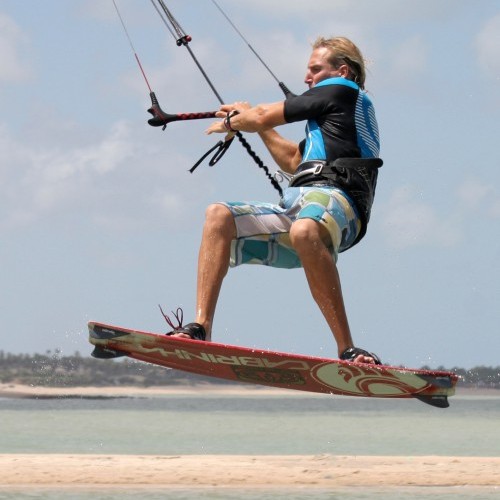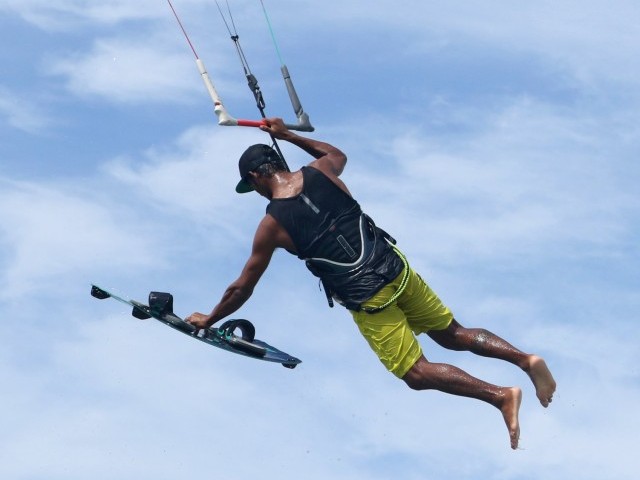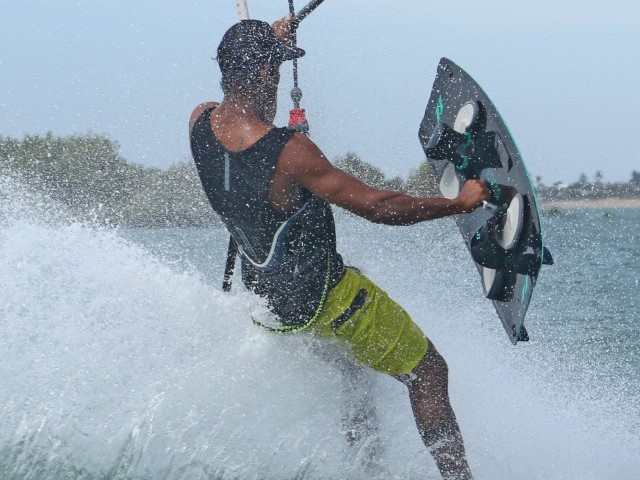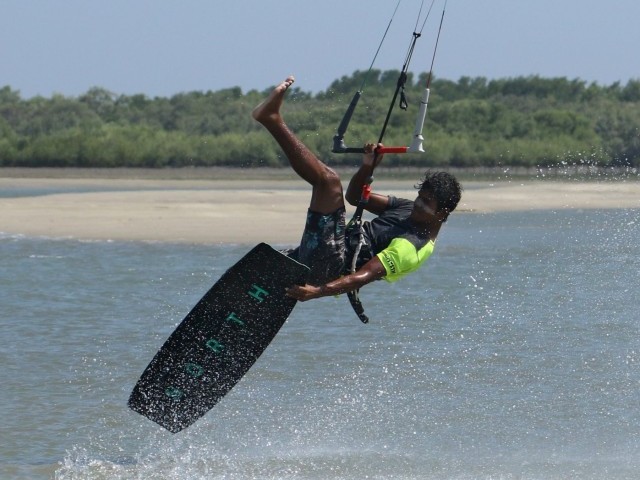
Front to Wrapped
Technique / Advanced
Introduction
Here’s a blinding move for you aspiring freestylers. The front to wrapped is an achievable pop move for anyone landing Shiftys to wrapped, and it also doubles as a great way to get into the non-inverted slim. Theoretically at least if you can perform a controlled unhooked front to toeside, then this move is but a step away….
The Foundation
So that toeside landing from an unhooked popped front? Lets ponder the theory for a brief moment before moving on to the full Monty.
Assuming that you have a strong toeside, chances are that on certain landings your body clicks into autopilot and pushes your strong foot out in front of you. This was the basis for you when first learning the shifty to wrapped or raley to toeside. Great news but in reality this self save mechanism generally only works when your body has time to take over. Therefore if you throw yourself into a fast spin, inertia will take over and you’ll just keep rotating. Hence you’ll be going for a slower rotation.
Have a quick look at Pic 1. from a front loop to toeside. You can see from the angle of the board compared to the kite lines that Christian has carved a long way upwind before popping. The result of this is that regardless of how hard he initiates his front roll, from this starting point it will have the effect of stalling his rotation speed, as he needs to pop up and into the rotation, rather than throw himself wildly down and round. In short his hands, the bar and even the board are in his way and he has more than 360˚ to rotate– all makes for a slower spin!
Added to this you want your feet to drop down to toeside, not rotate around to heelside. By this we mean that your objective is not to turn a heelside landing into a toeside landing at the last moment, but rather your feet to drop down from behind you to toeside without any effort. Only this will give you the ability to “pull” the landing to wrapped. This means that as well as rotating slowly you’ll need to lead from your head and shoulders, and not bring your knees up and through as you would for a front loop. If you do this, your legs will be left behind and gravity will take over.
In Pic 2 you can see that Christian’s head and shoulders have all but completed the rotation. His legs however are trapped in a time warp and are following some way behind. Many of you will be used to bringing your front knee up and through in a front loop, but here the point is to forget your legs, and as long as you’re ready for the landing with your head and shoulders, the board will drop down to toeside.
Finally have a look at Sequence 1. It demonstrates the “slow” concept. The move is quite spread out, as Christian slowly rotates and drifts with the kite until he and his legs start to drop, which then leads into the wrapped.
Approach
Pic A. This should be familiar territory for many of you, as we’re after the usual ingredients for good unhooked pop. Christian has his kite parked somewhere 10.30 and 11 o’clock, he’s carving hard upwind with his bum low, shoulders back and arms slightly bent. The bent arms are a must for this trick as you need to keep yourself close to the bar. Christian has his front leg pretty extended, with his hips over his back foot. He’s resisting with his back leg and is ready to pop off it once he’s carved a fair way into the wind.
Take Off
Pic B. During the take off you need to keep your arms in close. Popping up will make this a lot easier. You will also need to get the kite where it should be as the chances are it will have risen slightly during your carve. Here you can see how Christian has popped up hard off his back leg, and he has his hands in close. Christian has also steered the kite down a little by pulling on his front hand, which also helps initiate his rotation, as Christian drops his front shoulder at the same time to turn under his hands.
Waiting
Pic C. This picture sums the move up and also demonstrates the similarity between a shifty to wrapped, a shifty 3 and the front to wrapped. Having rotated slowly Christian has his eyes focused on where he’ll land. His feet are catching up but are still behind him. The objective here is to wait until you feel that your feet are dropping down, as that is the sign to go for wrapped. That said, just like with pretty much everything in life, it’s all about timing. If your feet start to drop but your kite is too high and you’re nowhere near landing, it probably won’t be pretty. So if you feel you are too high, just wait, land toeside and next time work on getting the kite down a tad more.
The Pull
Pic D. As mentioned, your legs dropping is the signal to go for wrapped. The reason is you’ll be using the momentum of your legs falling to bring them through and up to turn to wrapped. If you let them drop and then go for wrapped, your legs will once again get left behind. Once they start to fall - use them.
Here Christian has reacted to his legs. He has pulled both hands in hard; aiming them to go past his right hip and at the same time brings his back (right) leg up towards the bar. When pulling on the hands it’s a good idea to give the kite a little tweak down, as this will make the rest of the move a lot easier. If the kite is too high, the lift will make landing and passing difficult. These two actions combined will start to turn his body the extra 180˚ to wrapped. As soon as his back knee comes up Christian bends his other leg, turns his head with the rotation and lets go with his front hand, thus allowing him to turn with the momentum he has produced.
The Landing
Pic E. Your aim is to get the board at to least downwind but preferably a bit further around, so that you’ll keep your speed and move towards the kite, making the pass out of wrapped easier. Also try to get your weight forward, so continue to turn your head to look where you should be going. In the picture Christian almost has too much weight back, which can lead to you bouncing out on landing. As you come down, even though you released your front hand you should carry on pulling the bar behind you back with your back hand and twist your wrist. This will place the bar correctly, and it’ll be waiting obediently for the pass.
Top Tips
We’ve pretty much covered them all above but if you tweak the kite down on take off and before pulling to wrapped it will make the bar a lot lighter, enabling you to get to wrapped and pass out.
Other than that getting the right amount of height so that you have enough room and time to pull to wrapped is essential. Banging out a few fronts to toeside to make sure you’re doing the same thing consistently before contemplating the wrapped will make things a lot easier.
Following Sequence 2
- Pic 1. Kite a tad lower than 11 o’clock Christian bears off the wind considerably, unhooks, drops his weight low and starts to carve into the wind.
- Pic 2. Christian aims to carve a long way up into wind, and he keeps his hands in close.
- Pic 3. As the kite starts to pull and just before the board slows Christian pops up hard by extending his back leg with all his might. At the same time he pulls his hands down towards him to get the bar closer to his body.
- Pic 4. Christian initiates his rotation by throwing his front shoulder down towards the water, and at the same time dips the kite by tweaking it with his front hand.
- Pic 5. In this position Christian can now throw his head around, looking back over his trailing shoulder, which will guarantee him enough rotation to get most the way around his front loop.
- Pic 6. With his eyes focused on where he thinks he’ll land Christian waits! He does not try and bring his legs around and through.
- Pic 7. As his legs start to drop, Christian pulls hard on both hands, trying to rip the bar past his back hip. At the same time he brings his knees up towards the bar. This will start rotating him the other way. If the kite feels like its lifting, tweak it down again whilst you still have two hands on the bar.
- Pic 8. As his body turns Christian releases his front hand, turns his head and keeps his knees up. Remember to twist your wrist, as this will make it easier to rotate your body.
- Pic 9. Coming in for the landing and you can see that Christian has his wrist and bar turned and ready. He is also turning his head to try and look where he is going, which will move his weight forward over the board.
- Pic 10. Christian lands with his board facing slightly off the wind and his arm wrapped around behind him – it’s a claimer.
- Pic 11. All that’s left to do is reach behind you with your free hand and pass the bar. The further you rotate the quicker you’ll need to do this as you’ll have more tension on the lines and the kite will be rising.
Common Problems
The hardest part to master at the beginning is the combination of pop and kite position. Like all pop moves, going into this with speed and commitment will make it easier, but it’s easier said than done.
If you feel that you don’t have enough height to pull to wrapped, the best option is to come in with more speed and pop up much harder.
If you feel that you’re dangling under the kite, chances are that you needed to pop harder, but instead chose to put the kite up a bit. Best bet here is to concentrate on tweaking the kite down before pulling to wrapped.
If you keep catching your heelside edge and falling onto your back it is because you are not swinging your legs under the bar. Make sure you keep your arms bent, and pull in hard with both hands, lifting your head before you release. This should bring your legs underneath you for the landing.
If you are bouncing out on landing, try to turn your head and shoulders more whilst you rotate and look at the nose of your board. This should lift your shoulders and drag your hips into a more central position.
Keystones
- Edge hard upwind
- Keep hands in
- Pop up over your hands to rotate
- Lead with head and shoulders
- Pull both hands hard past your back hip
This technique article was in Issue 26 of IKSURFMAG.
Related
By Christian and Karine
Christian and Karine have been working together as a coaching team, running improver to advanced kitesurfing clinics since 2003.































